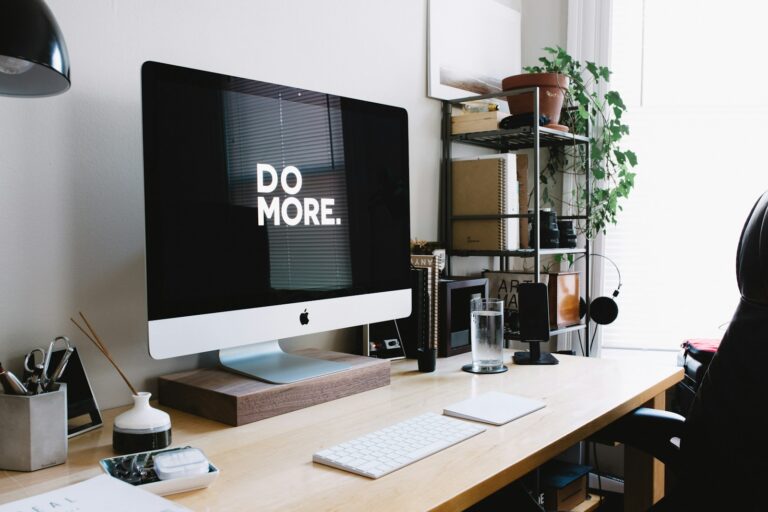Ever have those days when you just can’t seem to get anything done? You’re not alone. We all experience moments when our productivity takes a hit, leaving us feeling frustrated and overwhelmed. However, there are practical, actionable steps you can take to boost your efficiency and get back on track. This guide will explore eight detailed tips, complete with examples, to help you maximize your productivity and make the most of your time!
Table of Contents

1. Prioritize Your Tasks
When your to-do list is overflowing, it’s easy to feel lost and unsure of where to start. Prioritizing your tasks is essential for focusing on what truly matters, allowing you to make the most of your time and energy. By identifying the most important tasks and tackling those first, you can ensure that your day is spent on activities that bring the most value.
- Make a To-Do List: Start by writing down everything you need to accomplish. This can be as simple as using a pen and paper or as advanced as a digital task management app like Todoist or Asana.
Example: If you have ten tasks to complete, list them all out, no matter how small. For instance, your list might include tasks like “Respond to client emails,” “Finish project proposal,” “Grocery shopping,” and “Schedule dentist appointment.”
- Focus on High-Impact Tasks: Once you have your list, identify the tasks that will have the biggest impact on your goals or overall productivity. These are the tasks you should tackle first.
Example: If you’re working on a project proposal that’s due soon, prioritizing this task over less urgent ones like grocery shopping or scheduling a dentist appointment ensures you meet your deadline.
- Avoid Multitasking: It might seem like multitasking helps you get more done, but it often leads to lower quality work and longer completion times. Focus on one task at a time to ensure you’re giving it your full attention.
Example: Instead of jumping between responding to emails and working on your project proposal, dedicate a set amount of time to each task. Finish your emails before moving on to the proposal.
2. Break Tasks into Smaller Steps
Large tasks can be overwhelming, leading to procrastination. By breaking them down into smaller, more manageable steps, you can make progress without feeling overwhelmed. This approach not only makes the task more approachable but also provides a clear path to completion.
- Divide and Conquer: Break larger tasks into smaller, actionable steps that you can tackle one at a time.
Example: If your task is to “Prepare for a presentation,” break it down into steps like “Research the topic,” “Create slides,” “Practice the presentation,” and “Gather feedback.”
- Set Mini-Deadlines: Assign deadlines to each smaller task to keep yourself on track. This helps maintain momentum and ensures that you make steady progress toward your goal.
Example: If your presentation is in a week, set deadlines like “Finish research by Tuesday,” “Complete slides by Thursday,” and “Practice by Friday.”
- Celebrate Small Wins: Recognize your progress as you complete each step, boosting your motivation and giving you a sense of accomplishment.
Example: After completing the research phase of your presentation, take a short break or reward yourself with something small, like a favorite snack.
Also read: Kaizen: 8 Small Steps to Big Productivity Wins!
3. Eliminate Distractions
Distractions are one of the biggest enemies of productivity. Whether it’s your phone, social media, or background noise, finding ways to minimize distractions can significantly boost your efficiency. Creating a focused environment allows you to concentrate better and work more effectively.
- Turn Off Notifications: Silence your phone and computer notifications while you work to prevent interruptions.
Example: Use the “Do Not Disturb” feature on your phone and computer to block notifications during work hours.
- Create a Dedicated Workspace: Set up a workspace that is free from distractions and conducive to focus. This space should be separate from areas associated with leisure activities.
Example: If possible, use a specific room or corner of your home as your workspace. Keep this area tidy and equipped with everything you need to work efficiently.
- Use Focus Tools: Consider using apps or browser extensions that block distracting websites during work hours.
Example: Tools like “Focus@Will” for concentration-enhancing music or “StayFocusd” for blocking social media can help you stay on task.
4. Use Time Management Techniques
Time management is key to staying productive and making the most of your day. Techniques like the Pomodoro Technique or time blocking can help you stay focused and efficient. These methods are designed to structure your time in a way that maximizes productivity while minimizing burnout.
- Try the Pomodoro Technique: Work for 25 minutes, then take a 5-minute break. Repeat this cycle to maintain focus and prevent fatigue.
Example: If you have a long report to write, use the Pomodoro Technique to break the task into 25-minute work sessions, with short breaks in between to recharge.
- Use Time Blocking: Schedule specific blocks of time for different tasks throughout your day. This ensures that each task gets the attention it needs without spilling over into other activities.
Example: Block out 9:00 AM to 11:00 AM for writing your report, 11:00 AM to 12:00 PM for responding to emails, and 1:00 PM to 3:00 PM for project planning.
- Track Your Time: Keep track of how you spend your time to identify and eliminate inefficiencies. This awareness can help you adjust your schedule to be more productive.
Example: Use a time-tracking app like “Toggl” to monitor how long you spend on each task. Review your logs at the end of the week to see where you can improve.
Also read: Stop Procrastination: 8 Practical Steps to Get Things Done Today!
5. Take Regular Breaks
It might seem counterintuitive, but taking regular breaks can actually help you stay productive. Short breaks allow your brain to rest and recharge, improving your focus and efficiency when you return to work. By giving your mind a chance to relax, you can maintain a higher level of productivity throughout the day.
- Incorporate Short Breaks: Take a 5-10 minute break after every 25-30 minutes of focused work. This helps prevent mental fatigue and keeps you energized.
Example: After 30 minutes of intense focus on a writing task, step away from your desk for a quick walk or stretch to clear your mind.
- Move Around: Use breaks to stretch, walk, or do a quick physical activity to refresh your mind and body. Physical movement helps to reduce stress and increase blood flow to your brain.
Example: Set a timer for a quick 5-minute yoga session or walk around your office or home to get your blood flowing.
- Avoid Burnout: Regular breaks help prevent burnout by giving you a chance to relax and reset, so you can return to work with renewed focus.
Example: Take a longer break during lunch, and make sure to step away from your workspace. Enjoy your meal without distractions to fully recharge.
6. Set Realistic Goals
Setting unrealistic goals can lead to frustration and decreased productivity. By setting achievable goals, you can maintain momentum and avoid feeling overwhelmed. Realistic goals help you stay motivated and ensure that your efforts are focused on what’s possible.
- Be Specific: Set clear, specific goals that are easy to measure and track. This clarity helps you understand exactly what needs to be done and keeps you focused.
Example: Instead of setting a vague goal like “Get more clients,” set a specific goal like “Reach out to 10 potential clients by the end of the week.”
- Keep It Achievable: Make sure your goals are challenging but realistic given your time and resources. Overly ambitious goals can lead to burnout and frustration.
Example: If you’re new to a fitness routine, start with a goal of exercising three times a week, rather than committing to a daily workout that might be hard to maintain.
- Adjust as Needed: Be flexible and willing to adjust your goals if circumstances change. Life is unpredictable, and your goals should be adaptable to your situation.
Example: If you fall behind on a project due to an unexpected event, adjust your deadline and reassess your priorities to stay on track.
Also read: Supercharge Your Productivity: 10 Morning Habits for Success
7. Plan Ahead
Planning ahead is crucial for staying organized and on top of your tasks. Taking a few minutes to plan your day, week, or month can make a significant difference in your productivity. A well-thought-out plan acts as a roadmap, guiding you through your tasks and helping you stay focused.
- Create a Daily Plan: Outline your tasks for the day each morning or the night before. This gives you a clear direction as soon as you start your day.
Example: In the evening, take 10 minutes to plan your tasks for the next day. Include high-priority tasks, appointments, and any deadlines you need to meet.
- Use a Planner: Keep track of your tasks, appointments, and deadlines in a planner or digital tool. This helps you stay organized and ensures you don’t overlook important responsibilities.
Example: Use a digital planner like NozomuNoto to manage your schedule. Sync it across your devices so you can access it wherever you are.
- Review and Adjust: Regularly review your plans and make adjustments as needed to stay on track. Flexibility is key to adapting to unexpected changes.
Example: At the end of each week, review what you accomplished and adjust your plan for the following week to reflect any changes or new priorities.
8. Stay Positive and Motivated
A positive mindset can do wonders for your productivity. When you’re feeling motivated and optimistic, you’re more likely to tackle your tasks with energy and enthusiasm. Cultivating a positive attitude not only makes work more enjoyable but also helps you overcome challenges more easily.
- Focus on Progress: Instead of dwelling on what you haven’t done, celebrate what you’ve accomplished. Recognizing your achievements keeps you motivated and builds momentum.
Example: At the end of each day, take a moment to reflect on what you completed, no matter how small. Acknowledge your progress and use it as fuel for the next day.
- Use Positive Affirmations: Remind yourself of your strengths and capabilities to boost your confidence. Positive self-talk can help you stay focused and resilient in the face of challenges.
Example: Start your day with affirmations like “I am capable of handling today’s challenges” or “I am focused and productive.”
- Stay Inspired: Surround yourself with things that inspire you, whether it’s music, quotes, or a supportive community. Inspiration can reignite your passion for your work and keep you moving forward.
Example: Create a workspace that reflects your goals and values. Decorate it with motivational quotes, inspiring images, or anything that lifts your spirits.
Also read: Boost Your Focus with the Pomodoro Technique: A Beginner’s Guide!
Conclusion: Boost Your Efficiency Today!
By implementing these 8 tips, you can boost your efficiency and make the most of your day. Whether it’s prioritizing your tasks, eliminating distractions, or staying motivated, these strategies can help you overcome productivity slumps and get back on track. Remember, it’s not about being busy—it’s about being productive and making progress toward your goals. Let’s boost our efficiency together and make today a productive day!



